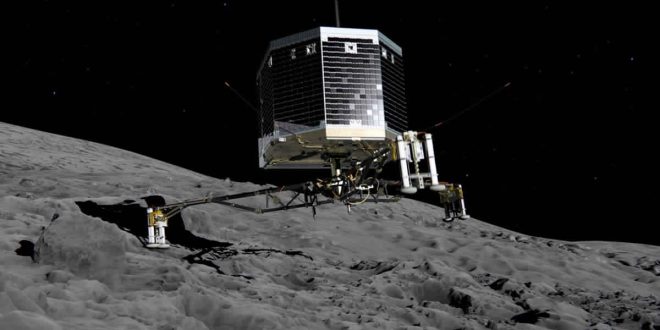The first spacecraft to land on a comet has now been cut off from Earth forever.
Mission controllers at the European Space Agency (Esa) took the decision after Philae had remained silent for a year. Keeping the link open would have drained vital power needed by its Rosetta mother ship, in orbit around the comet.
Philae’s landing on comet 67P/Churyumov-Gerasimenko in November 2014 was bumpier than planned after the probe failed to anchor itself to the surface.
It eventually came to rest in a shady spot that prevented sunlight reaching its solar panels.
After 64 hours of experiments Philae’s batteries died and the probe went into hibernation. As the comet approached the sun in June and July last year, the brighter light allowed the lander to wake from its slumber briefly, before shutting down again.
Currently the comet and its visitors from Earth are some 520 million kilometres (323 million miles) from the sun. At this distance, the sun’s rays are too faint to keep the spacecraft topped up with power.
At the end of September, Rosetta will finish its mission in dramatic style by joining Philae on the comet surface.
Until then, scientists want to squeeze as much data as they can from the probe. To do that, they have to keep power flowing to its instruments.
In the run up to Rosetta’s finale, they decided to turn off the Electrical Support System Processor Unit (ESS) on Rosetta which enables communication between the lander and mother ship.
Professor Monica Grady, from the Open University, a leading member of the Philae science team, said: “It’s sort of the end of an era. They’ve finally pulled Philae’s life support.
“Realistically, we’ve known for about a year that there wasn’t going to be any further communication with Philae, although we kept hoping.
“Rosetta is so far away, it needs all the power it can get because the solar panels are not getting enough energy from the sun. So every unnecessary bit of power has to be switched off.”
She said Philae had been a “phenomenal success”.
“It did about 80% of the science it was supposed to do,” said Prof Grady. “We got all sorts of interesting results. We found that the surface of the comet was so much harder than we anticipated and very black, and full of the molecules we’d hoped to find, including biological precursor molecules. It was an amazing achievement; absolutely worthwhile.”
Rosetta is due to make a “controlled” crash landing onto the same lobe of the 2.5-mile (4km) long duck-shaped comet where Philae is located, but some distance away in a region known as Ma’at.
Prof Grady said: “It will be a gentle touch down until the last second … Rosetta will be collecting data right up to the end.”
Rosetta project scientist Dr Matt Taylor said: “We’re trying to squeeze as many observations in as possible before we run out of solar power.
“30 September will mark the end of spacecraft operations, but the beginning of the phase where the full focus of the teams will be on science. That is what the Rosetta mission was launched for and we have years of work ahead of us, thoroughly analysing its data.”
Agencies/Canadajournal

 Canada Journal – News of the World Articles and videos to bring you the biggest Canadian news stories from across the country every day
Canada Journal – News of the World Articles and videos to bring you the biggest Canadian news stories from across the country every day

